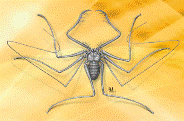Papers in the Biological Sciences

Eileen Hebets Publications
Document Type
Article
Date of this Version
2016
Citation
Published in Ethology 122 (2016), pp 95–104. doi 10.1111/eth.12449
Abstract
Most hypotheses related to the evolution of female-biased extreme sexual size dimorphism (SSD) attribute the differences in the size of each sex to selection for reproduction, either through selection for increased female fecundity or selection for male increased mobility and faster development. Very few studies, however, have tested for direct fitness benefits associated with the latter – small male size. Mecaphesa celer is a crab spider with extreme SSD, whose males are less than half the size of females and often weigh 10 times less. Here, we test the hypotheses that larger size in females and smaller size in males are sexually selected through differential preand postcopulatory reproductive benefits. To do so, we tested the following predictions: matings between small males and large females are more likely to occur due to mate choice; females mated to small males are less likely to accept second copulation attempts; and matings between small males and large females will result in larger clutches of longer-lived offspring. Following staged mating trials in the laboratory, we found no support for any of our predictions, suggesting that SSD in M. celer may not be driven by pre- or post-reproductive fitness benefits to small males.
Included in
Animal Sciences Commons, Behavior and Ethology Commons, Biology Commons, Entomology Commons, Genetics and Genomics Commons


Comments
Copyright © 2016 Blackwell Verlag GmbH. Used by permission.